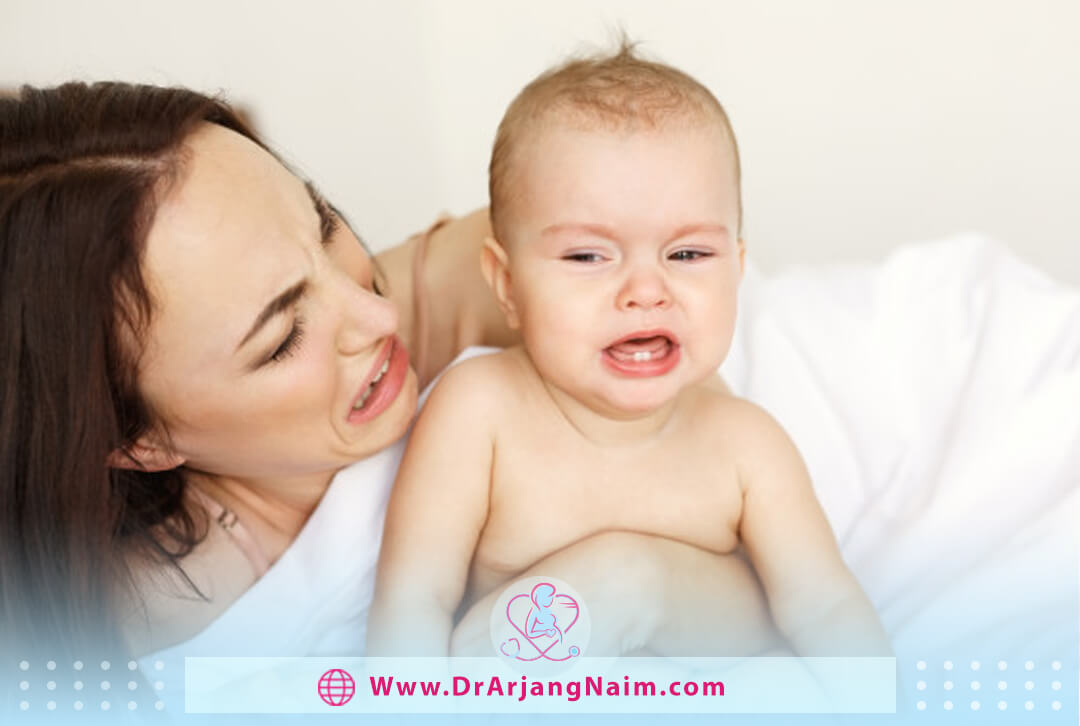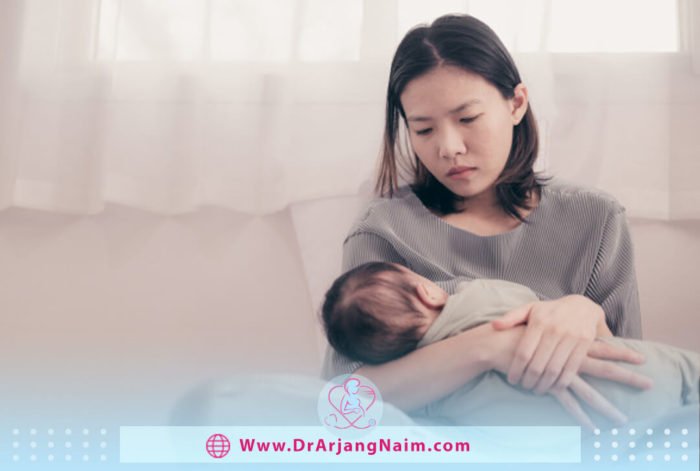The birth of a baby can evoke powerful emotions ranging from excitement and joy to fear and anxiety. But it can also lead to depression. About 50 to 75% of new mothers change their emotions after giving birth, called “Baby blues” Up to 15% of these women experience more severe and prolonged postpartum depression.
Most new mothers experience “Baby blues” after giving birth, which usually include mood swings, crying, anxiety, and trouble sleeping. Baby blues usually start in the first two to three days after birth and may last up to two weeks. But some new mothers experience more severe and prolonged depression, known as postpartum depression. Rarely, a severe mood disorder called postpartum psychosis may also occur after childbirth.
Types of postpartum depression
Types of depression include:
- Postpartum blues: This condition is better known as ” Baby blues “; it affects between 50 and 75% of postpartum women. If a woman experiences blues, she will have frequent, prolonged crying for no apparent reason, grief and anxiety. The disease usually starts in the first week (one to four days) after delivery. Although this is an unpleasant experience, it usually resolves within two weeks without treatment.
- Postpartum depression: This condition is much more serious than postpartum blues and affects one in ten mothers. If the mother has had postpartum depression, the chances of experiencing it again increase to 30%. This condition is accompanied by feelings of frequent crying, irritability, and fatigue. Symptoms range from mild to severe and may appear within a few days of delivery or gradually, even up to a year later. Although symptoms may last from a few weeks to a year, treatment with psychotherapy or antidepressants is very effective.
- Postpartum psychosis: This is a very severe form of PPD and requires immediate medical attention. This condition is relatively rare and affects only one in every 1,000 women postpartum. Symptoms generally occur quickly after delivery and are severe, lasting from a few weeks to several months. Postpartum psychosis requires immediate medical attention because of the risk of suicide and the risk of harm to the baby increase. Treatment usually includes hospitalization and medication in the hospital.
Symptoms

Symptoms of postpartum depression vary from mild to severe.
Baby blues symptoms
Signs and symptoms of baby blues include:
- Crying
- Mood swings
- Anxiety
- Sadness
- Irritability
- Feeling overwhelmed
- Reduced concentration
- Appetite problems
- Trouble sleeping
Postpartum depression symptoms
Postpartum depression may be confused with baby blues at first, but its signs and symptoms are more severe and prolonged and may eventually interfere with the baby’s ability to care for and perform other daily tasks. Symptoms of PPD include the following:
- Depressed mood or severe mood swings
- Excessive crying
- Withdrawing from family and friends
- Loss of appetite or eating much more than usual
- Severe anxiety and panic attacks
- Recurrent thoughts of death or suicide
- Restlessness
- Diminished ability to think clearly, concentrate or make decisions
- Inability to sleep or sleeping too much
- Overwhelming fatigue or loss of energy
- Intense irritability and anger
Postpartum psychosis
Postpartum psychosis is a rare disease; signs and symptoms include:
- Confusion and disorientation
- Hallucinations and delusions
- Sleep disturbances
- Excessive energy and agitation
- Paranoia
- Possibility of harming the mother to herself or the baby
Causes
More research is needed to determine the link between rapid hormone drop after childbirth and depression. Levels of estrogen and progesterone (the female reproductive hormones) increased tenfold during pregnancy but fell sharply after delivery. Three days after delivery, the levels of these hormones drop to pre-pregnancy levels. In addition to the chemical changes, the social and psychological changes associated with having children increase the risk of postpartum depression. Factors that increase the risk of PPD include:
- Past trauma
- Hormonal fluctuations
- A previous diagnosis or family history of depression or bipolar disorder
- The physical and emotional stress of delivery and childcare
- Added stress at work or home
- Difficulty sleeping
- Feeling overwhelmed
- Feeling unattractive
- Not having any free time
- Having breastfeeding difficulties
- Having a substance use disorder
- Having a baby with special needs
- Having had an unwanted pregnancy
- Being younger than 20
- Having a lack of support from family and closest friends
- Experiencing preterm birth
- Having a baby with a low birth weight
Prevention
Postpartum depression cannot be completely prevented. However, if a mother has a history of depression, she can prepare for it to recur. Preparation includes mental and physical health. Exercise, healthy eating, and learning stress-reduction strategies can help during pregnancy.
Avoiding alcohol and caffeine, asking for help from others, sleeping while the child is asleep, following a proper diet, strengthening the relationship with the spouse, having a social relationship, and seeing a doctor if the mother has depression symptoms are some of the solutions that It can be done after the baby is born.
Complications
Postpartum depression, when left untreated, can weaken a mother’s ability to bond with her baby and affect the whole family.
Mother
Untreated postpartum depression can last for months or more, even becoming a chronic depressive disorder. Even with treatment, PPD can increase the risk of future depression.
Father
When the mother is depressed, the father is also likely to be affected.
Children
Children of mothers with postpartum depression are more likely to have trouble sleeping and eating, cry too much, and delay language development.
Treatment

Untreated depression can be confusing and even frightening and worsen the condition. You need to know that this complication is very treatable, so you do not need to be afraid or have bad anxiety. Treatment helps prevent deep depression. Also, having a counselor or doctor who understands the situation can help you feel less alone. By treating depression, you can more easily connect with your child and take better care of him or her. So, if you have symptoms of depression, see your doctor so you can start going to counseling for treatment or medication.
Baby blues
Baby blues usually fade within a few days to two weeks. Strategies that can help improve this condition include:
- Avoid alcohol and recreational drugs
- Connect with other new moms
- Accept help from family and friends
- Adequate rest of the mother
Postpartum depression
Postpartum depression is often treated with psychotherapy, medication, or both.
Psychotherapy
Psychotherapy may help the mother talk to a psychiatrist, psychologist, or other mental health professional about her concerns. She can find better ways to cope with his emotions, solve problems, set realistic goals, and respond positively to situations through treatment. Sometimes family or relationship therapy can also help.
Antidepressants
The doctor may recommend antidepressants. If the mother is breastfeeding, any medication she takes will enter her breast milk. However, most antidepressants can be used while breastfeeding with little risk of side effects for the baby.
With proper treatment, the symptoms of postpartum depression usually improve. In some cases, PPD can progress into chronic depression. Treatment should be continued after the mother has recovered. Stopping treatment too soon may lead to recurrence.
Postpartum psychosis
Postpartum psychosis requires immediate treatment, usually in a hospital.
Medication
Treatment may require a combination of medications such as antipsychotics, mood stabilizers, and benzodiazepines to control signs and symptoms.
Electroconvulsive therapy (ECT)
Electroconvulsive therapy may be recommended if postpartum depression is severe and symptoms do not subside after taking the medication. ECT is a method in which small electrical currents are passed through the brain and intentionally cause a brief seizure. ECT appears to cause changes in brain chemistry that can reduce the symptoms of psychosis and depression, especially when other treatments fail.
Tips for dealing with postpartum depression
Although the best way to treat depression is to seek help from a specialist doctor, after consulting a doctor and relevant counselors, there are solutions that the mother can use. These solutions include:
- The sufferer should ask for help from others and let those around them know how they can help her
- Have realistic expectations of herself and his baby
- Exercise, walk, and get out of the house
- The sufferer should know that everyone has both good and bad days in the life
- A sensible diet can be very helpful; It is best to avoid alcohol and caffeine
- Husbands and wives should strive to nurture and improve their relationship with their partner
- The patient should interact with family and friends
- It should not be crowded when the mother comes home from the hospital after giving birth
- It is better to make video phone calls with his friends and relatives so that she does not feel isolated
- when the baby is asleep, the mother should rest well
Postpartum depression in men

It is not uncommon for new fathers to have Baby blues for some reason. Fathers’ depression also goes away after a few weeks. Men can also develop a type of PPD called paternal postpartum depression.
Symptoms
The symptoms of depression are similar in men and women but may occur gradually in fathers, making it more difficult to diagnose. There is also less information and fewer systems to assist new fathers in coping with these feelings.
Men are less probably to report depressive symptoms, but estimates suggest that up to 25 percent of fathers feel depressed in the first year after giving birth. Fathers are more anxious for the first time in the weeks after birth.
Causes
There are not many studies on the causes of postpartum depression in men. Researchers say it may be linked to changes in testosterone and other hormone levels. It may be related to lack of sleep, stress, and changes in family dynamics.
Risk factors
If the mother is depressed, the father is more likely to develop depression, and another risk factor is previous depression or other mood disorders.
The bottom line
In the first days and weeks after giving birth, a person who has just become a mother experiences a variety of emotions. She may have new and beautiful feelings of pride, joy, and happiness, and she may also experience unpleasant feelings such as sadness and unhappiness. Some of these feelings are normal and return to normal after a few weeks, but some are abnormal and may persist for months, which is called postpartum depression. Familiarity with the symptoms and treatment of postpartum depression will reduce the anxiety of this disorder, and the person will return to a normal routine more quickly.
Postpartum baby blues are a common psychological disorder, and its severity often subsides within a week or two. This type of discomfort is often associated with major hormonal changes that occur after birth.
Women who have given birth and have been experiencing discomfort, anxiety, or worry for several weeks may be experiencing postpartum depression. While baby blues often go away quickly, postpartum depression can last longer and significantly affect a person’s ability to return to normal daily life.
Treatment time for postpartum depression varies according to the severity of the depression and the individual’s needs. If there is hypothyroidism or another acute illness, your doctor may treat these conditions and refer you to a specialist.
Dr. Arjang Naim, MD, after examining the condition of the mother who is feeling depressed and examining her other medical condition and eliminating it, will refer the person to psychologists if necessary.
Additional questions
- What are the symptoms of hormone fluctuations?
- Constipation
- Diarrhea or more frequent bowel movements
- Numbness and tingling in hands
- Depression or anxiety
- Slow heartbeat or rapid heartbeat
- Unexplained weight gain or weight loss
- What do antidepressants do to a person?
Antidepressants increase the activity of chemicals called neurotransmitters in the brain. It seems that increasing the activity of the neurotransmitters norepinephrine, serotonin, and dopamine helps to reduce the symptoms of depression and anxiety.
- What is the most commonly used mood stabilizer?
Lithium is the most widely used mood stabilizer.
- What’s the difference between PND and PPD?
Perinatal depression (PND) is a term sometimes used interchangeably with postpartum depression (PPD), but typically refers to major or minor depression that begins during pregnancy or up to 12 months after delivery.
- Who is more likely to get PPD?
The risk of postpartum depression is higher among mothers younger than 25, first-time mothers, and mothers of twins.
References
https://www.healthline.com/health/depression/postpartum-depression#facts
https://www.mayoclinic.org/diseases-conditions/postpartum-depression/symptoms-causes/syc-20376617
https://my.clevelandclinic.org/health/diseases/9312-postpartum-depression
https://www.medicalnewstoday.com/articles/237109
https://www.psychiatry.org/patients-families/postpartum-depression/what-is-postpartum-depression
https://www.webmd.com/depression/postpartum-depression/understanding-postpartum-depression-treatment
https://www.marchofdimes.org/pregnancy/postpartum-depression.aspx




